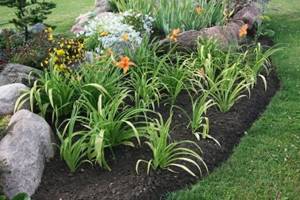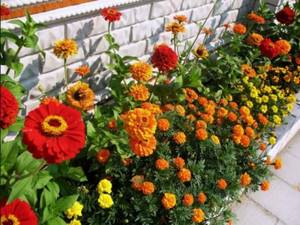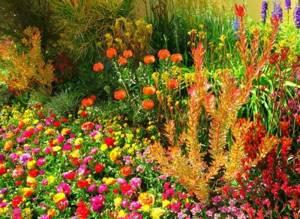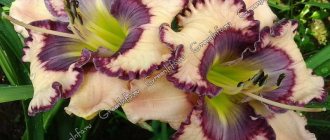Daylilies in the landscape design of a summer cottage, garden, even a small vegetable garden are at the peak of popularity among modern gardeners. When most plants finish blooming in the spring, these varieties provide a wide variety of colors and shapes throughout the summer season. It is also important that the plants are unpretentious in care, winter well and withstand the sun in mid-summer. A skillful combination of daylilies with other plants will make the site unforgettably beautiful.
Bright and juicy flowers will decorate any landscape
Features of using daylilies in garden landscape design
Daylily, or Krasodnev, is a beautiful, herbaceous plant that does not require complex manipulations in care. It is considered decorative and is widely used in landscaping and design of gardens, personal plots, and public places. Different types of plants grow independently in the wild, mainly in the Far East - China, Korea, Japan. Daylilies have been able to adapt to the conditions of the Russian climate; wild species grow in the southern regions of Siberia to the upper reaches of the Ob River in the west.
It has good resistance to disease and harsh weather conditions. It grows in shade, partial shade, and in the sun its flowering is most abundant. Requires at least 6 hours of exposure to the rays per day.
Daylily is a perennial herbaceous plant. Among all the varieties, only one is evergreen - Hemerocallis aurantiaca. The roots are cord-like, thickened, and sometimes form short-lived shoots. Wide-linear foliage is arranged in two rows, depending on the variety - straight or curved into an arc. Bright large flowers are the main feature of daylily. The color range is from yellow to reddish brown. The shape is funnel-shaped, with six petals. Arranged in inflorescences of 2 to 10 flowers.
Attention! The flowering period lasts about a month, but the buds bloom in turns, 1-3 flowers within 1-2 days. Some varieties bloom primarily at night.
Peduncles reach 1 m in height. For decorative purposes, they are conventionally divided into low specimens (up to 30 cm), medium (30-60 cm), semi-high (60-90 cm) and high (more than 90 cm). Fruits in triangular capsules with a small number of seeds.
Tips for planting and care
Daylily loves sunny places, without stagnant groundwater. The plant is most often propagated by dividing the rhizomes.
How to plant
1. When planting, prepare the planting hole: dig up the soil onto the bayonet of a shovel, add humus or compost, a little peat or sand to it.
2. Straighten all the roots of the plant.
3. We do not deepen the root collar of the division.
4. Gently press the soil around the plant with your hands.
5. Water and mulch. _______________________________________________
Read more about how to grow healthy and lush-flowering daylilies in this article _______________________________________________
How to care
In the first year after planting, we do not fertilize, and in subsequent years we apply organic or mineral fertilizers (depending on what you have) 2 times per season: before setting buds and the second time during flowering.
Likes moderate watering. But it also feels good without watering. My daylilies are watered by rain, only if there is an abnormal drought, which is not uncommon in recent years, then I can sprinkle them a little in the evening.
Furniture in a modern style - 80 photos of different types of stylish, practical and relevant furniture
Bloom
If there are few flowers and some valuable variety, then after the flower has faded, and each flower blooms for 1 day, we carefully pluck it out so that the plant does not waste energy on setting seeds, but builds up the root system. This is the case if we do not need seeds for selection.
When the bush is large, and there is no time or opportunity to remove every faded flower, it’s also okay, the plant will grow as usual, as in nature.
Types of compositions with daylilies in landscape design
Daylilies look harmonious in any landscape and combine well with other plants. And the right location and composition will help create a true work of art. Tapeworms (single plantings) and mixed “mixborders” are planted approximately according to the following schemes:
- Low varieties are planted on alpine hills and rocky places.
- Daylilies are used to create hedges along borders, fences and fences.
- Individual compositions are installed in the middle of clearings, on lawns and ridges.
- Decorate patios, on the sides of steps, and terraces with pots, tubs and containers.
- Given the pleasant aroma emanating from flowering plants, they are often grown near benches and around gazebos.
Low daylilies are planted singly along paths. Compositions of different plant varieties are planted along the alleys, with tall representatives of the flora in the background and miniature bushes in front. Daylilies and hostas are noted in landscape design, when the former have large bright buds that contrast with the shrubs.
Daylilies and hostas look great in contrasting colors
Attention! Tall specimens with dark buds are usually combined with small light representatives of the fauna for better contrast.
Having a daylily variety with a round or star-shaped bud, it is planted in a group with pyramidal or spherical flowers, for example, different types of hydrangea.
There are types of daylilies that have a greenish core, which is often used by gardeners in a combination of bright and contrasting shades of flowers of other representatives of the fauna.

When the daylily has a yellow core, it can be easily combined with hostas of the same color
Red daylilies are planted mainly with yellow tones of other flowers.

Dark varieties are harmonious with light fauna

It is better to calm down bright and variegated shades with soft colors, coniferous, warm tones
If you exclude the use of other flowers and shrubs, daylilies combine well with each other or in a single composition.

You can choose the color scheme wisely, for example, a single color, but in different shades
The dominant color is chosen to be the one that has a lighter shade and is placed in the center. Around it it is decorated with slightly darker flowers and, moving away from the middle, the colors become darker and more saturated.
You can use a multi-layer effect when dense tall bushes are planted in the background, medium-sized bushes in front of them, and so on lower. The color of the buds can be monochromatic or in many shades.

Miniature bright daylilies will look great near rocky structures, as well as alpine hills
And if there is a stream, pond, or artificial waterfall on the site, then there are special varieties of daylilies that tolerate excess moisture well. In addition, near a pond they will have a special harmony with lilies, phlox, and astilbes.
Mixborder organization
Mixborder is also called mixed border. This is a widespread but challenging flower garden variety. To create it you need to have imagination, love plants and have certain knowledge. In addition, organizing such a border requires a lot of work.
Planting scheme
In order for the border to become a real decoration of the site, when creating it you need to adhere to the planting scheme. It requires compliance with the following rules:

- Flowers are placed in spots, groups or broken lines.
- Tall species are planted either in the background or in the center of the flower bed. Low-growing plants are brought to the foreground.
- The basis of the composition is created by large perennial flowers. These can be delphiniums, lilies, perennial asters, peonies and others.
- Perennial flowering plants and ornamental grasses of medium height should be planted in the middle ground. For example, irises, cereals, phlox, daisies, ferns.
- It is not worth planting them closely, since by 3-4 years the perennials grow and become decorative. To avoid empty space, in the first year you can place annual flowers between the bushes - asters, marigolds and others.
- The foreground is decorated with ground cover perennial plants, for example, thyme, dwarf irises or sedum. Also suitable are low annuals - lobelia, purslane.
In order for the mixborder to look decorative in the spring, bulbous flowers are planted in it. In this case, it is also better to adhere to a certain order:
- In the foreground are plants with small bulbs and hyacinths placed between perennials.
- Medium shot - tulips and daffodils.
- The background is gladioli and lilies blooming in summer.
In this flower garden it is not recommended to grow plants with underground stolons or creeping rhizomes, since their growth is almost uncontrollable. These flowers include lilies of the valley and spurge.
Selection of shades
The color scheme when creating a flower garden is no less important than the correct planting of plants. So, there are borders:

- Monochrome, in which only one shade predominates, for example, red. Flowers with red petals are selected for it, as well as plants with decorative foliage framed with a red border.
- Closed, that is, flowers of similar colors are planted in the flower garden, for example, pastel (white, pink, light lilac).
- Contrasting plants combine plants of two opposite colors. For example, orange and purple, blue and yellow.
- Classic mixborders are polychrome, that is, they contain combinations of several (from three to seven) shades.
Beautifully designed flower beds with properly selected plants can decorate any garden plot. In the process of creating a flower bed, it is very important to take into account not only the combination of different shades of petals, but also the size of the plants, as well as their flowering periods.
Loading…
Caring for daylilies in landscape design
Before planting daylilies, you need to know a number of minor rules and conditions for their maintenance. It is worth remembering that only some varieties bloom well in direct sunlight, while most should be provided with partial shade. Almost any soil is suitable for them, even with an acidic reaction. It is possible to use liming, which will make the soil suitable for further development of the flower. After the daylily has faded, the plant is fed with sulfate at the end of summer. Watering is done by “sprinkling” throughout the night, i.e. an irrigation system is required.
Daylily is propagated by dividing the bush, preferably in early spring or autumn. In order for the plant to adapt faster, you need to remove all the foliage. When planting, the pit is fertilized with potassium sulfate; no further replanting is required.
Attention! Daylily can bloom for about twenty years in one place.
Therefore, it is worth carefully planning possible compositions, colors and combinations with other plants in advance. It is worth considering what plan to plant the daylily on, what place it will occupy in group seedlings, because this moment has its own rules.
Daylily genus
Daylilies belong to the hemerocallis (lat. beautiful during the day), or red daylilies, this is due to the fact that the inflorescences bloom in the early morning and bloom only for one day. But behind the riotous appearance of more and more new buds, the process of hemerocallis is almost invisible, although many gardeners try to capture it in a photo.
They are characterized by unpretentiousness, endurance and drought resistance. Flowers do not need any special conditions or care, they feel great on any soil cover, quickly grow and reproduce, and are practically not susceptible to diseases and pests. The only thing that can cause harm is a lack of sunlight and stagnant water in the soil. In the first case, the plant stops blooming, and in the second, the root system is subject to putrefactive processes.
Despite the unpretentiousness of daylily, it is still necessary to ensure that the soil is moist, fresh, with good drainage; neutral or slightly acidic soil is desirable. Also, when planting a small one, you should take into account that a small sprout will very quickly grow into a large plant with a diameter of up to 70 cm. In addition, daylily is a perennial plant, so when choosing a place for a flower, you should take into account that it will need free space and a lot of sunlight.
Slaughtering rabbits: methods and devices. How to skin a rabbit? Rabbit cutting
In order for the plant to take root and begin to delight with lush flowering, when planting you should follow a few simple rules. The roots of the seedling must be shaken off the ground and washed under running water, carefully inspect the roots for various damage and rot. You can see what healthy plant roots look like in the photo. All suspicious areas of roots must be cut off, and the remaining roots should be treated with a solution of potassium permanganate or a fungicide. This will protect the plant from possible diseases and allow the root system to strengthen faster.
After treating the roots, the daylily seedling is rooted into the prepared hole, but not too deep, otherwise stagnation of water will form in the soil, which will lead to putrefactive processes.











